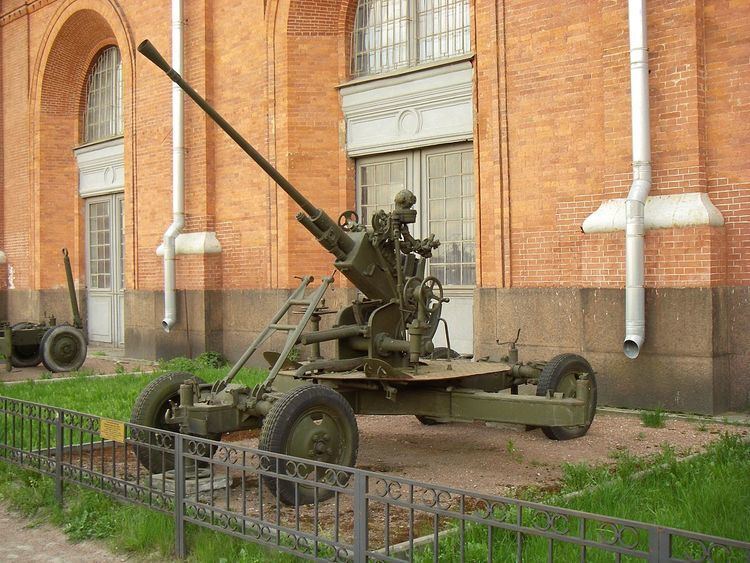Type Air defense gun Used by Users No. built 20,000 (USSR) | Produced 1939–1945 (USSR) | |
 | ||
Wars | ||
37 mm automatic air defense gun M1939 (61-K) (Russian: 37-мм автоматическая зенитная пушка образца 1939 года (61-К)) was a Soviet 37 mm caliber anti-aircraft gun developed during the late 1930s and used during World War II. The land based version was replaced in Soviet service by the ZSU-57-2 during the 1950s. Guns of this type were successfully used throughout the Eastern Front against dive bombers and other low- and medium-altitude targets. It also had some usefulness against lightly armored ground targets. Crews of the 37 mm AD guns shot down 14,657 Axis planes. The mean quantity of 37 mm ammunition to shoot down one enemy plane was 905 rounds.
Contents
Development
The Soviet Navy purchased a number of Bofors 25 mm Model 1933 guns in 1935, trials of the weapon were successful and it was decided to develop a 45 mm version of the weapon designated the 49-K. The development under the guidance of leading Soviet designers M. N. Loginov, I. A. Lyamin and L. V. Lyuliev was successful, but the army thought that the 45 mm calibre was a little too large for an automatic field weapon. In January 1938 the Artillery Factory Number 8 in Sverdlovsk was ordered to develop a 37 mm weapon based on the same design. The task was fulfilled by the chief designer of the Factory Mikhail Loginov and his assistant Lev Loktev. Firing trials of the new 61-K were conducted in October 1938.
Competitive firing trials were conducted in 1940 between the 61-K and the Bofors 40 mm/56. They found that there were no substantial differences between them.
Land version
The weapon was initially installed as a single barrel weapon on a four-wheeled ZU-7 carriage, and was soon ready for service. An initial order for 900 units was placed. The gun was operated by a crew of eight men. A total of 200 rounds of ammunition were carried which were fed into the gun in five round clips. Total Soviet production was around 20,000 units, ending in 1945. However, it has also been produced in Poland, China and North Korea.
Armour penetration of the armour-piercing (AP) rounds is reported as 37 millimetres of Rolled homogeneous armour (RHA) at 60°at 500 metres range and 28 millimetres of RHA at 90° at 1500 meters range.
Naval version
The naval mounting was produced as the 70K, and had entered service before the German invasion of the Soviet Union replacing the semi-automatic 45 mm/46 21-K on many ships. It was fitted in large numbers to Soviet ships during the Second World War, notably the T301 class minesweeper. The V70K was produced until 1955, with a total of 3,113 built.
One drawback was that the 70K required a barrel change after every 100 rounds fired. To improve on this, a twin barrelled water cooled mount, the V-11 (called "W-11" in East Germany and Poland because of different Cyrillic transliteration), entered service in 1946, and was in production until 1957. A total of 1,872 V-11 mounts were built.
After this an 85-caliber 100 mm (3.9 in) anti-aircraft mounts long version, the 45 mm/85, was developed and accepted into service in 1954, it was deployed in twin and quad turrets on a number of classes of vessels, including the Neustrashimyy, Kildin and Kotlin class destroyers. However it was later replaced with the ZIF-31 twin 57 mm mounting.
The 37 mm twin mounting was exported to China where it was manufactured and used extensively, as the "Type 65". A turret based version was produced from the late 1980s called the "Type 76" or H/PJA 76.
ZSU-37
The ZSU-37 was developed late in the Second World War, it was a single 37 mm gun mounted in a large open turret on the chassis of the SU-76 self-propelled gun .
Specifications
Ammunition
The cannon fires 37×252SR shells. The shells use brass cases lined with waxed paper and use KV-2U percussion primers. A small piece of lead-tin wire is included in the case to act as a de-coppering agent, to counteract the buildup of copper from the driving bands of the projectiles. The Ammunition is produced in a number of countries including China, Russia, Egypt, Pakistan and Yugoslavia. The projectiles themselves are identical to those fired by the NS-37 aircraft cannon. The explosive shells are fitted with point detonating fuzes making them unsuitable for engaging fast moving or small targets.
Variants
Users
Afghanistan
Albania
Algeria
Angola
Bangladesh
Bulgaria
Cambodia
Cameroon
Cuba
Egypt
Ethiopia
East Germany
Finland
Gabon
Guinea
Guinea-Bissau
Indonesia
Iraq
Israel
ISIS
Laos
Mali
Mauritania
Mongolia
Morocco
Mozambique
Namibia
Nicaragua
North Korea
Pakistan
People's Republic of China
Poland
Republic of the Congo
Romania
Somalia
Soviet Union
Sudan
Syria
Tanzania
Thailand
Togo
Tunisia
Uganda
Vietnam
Yemen
Yugoslavia
Zaire
Zambia
Zimbabwe
